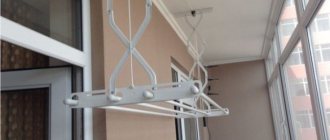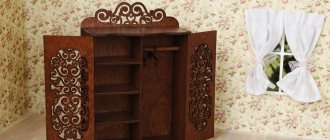Every housewife tries to equip the kitchen as functionally as possible. This room houses equipment and items that are necessary not only for the main process - cooking, but also to increase comfort while staying and working. In any kitchen there should be a place for a structure whose purpose is to dry dishes and cutlery.
Dish drying rack in the cupboard
Manufacturers offer a wide variety of models, differing in installation location, dimensions, design, material of manufacture and performance characteristics. They allow you not only to place dishes for drying, but also to organize storage space for the most frequently used items.
What are the requirements for dryers?
After washing, the dishes should dry. It can be wiped dry by hand or left to dry on the table, but it is more convenient to place it in a dryer specially designed for this, where it is installed on an edge or upside down. There it will dry quickly and you won’t have to put any effort into it. There will be no streaks or stains on naturally dry plates and glasses.
Kitchen cabinet dryer
Strict sanitary requirements are imposed on utensils and equipment used in food preparation, since people’s health depends on their cleanliness. Therefore, the equipment of the place where they are stored should be approached responsibly. It is necessary to take into account both the aesthetic aspect and the main purpose of the dryers.
Despite the simplicity of the device, some nuances are important to consider when choosing them.
- All structural elements must not be exposed to water. Their coating must ensure the absence of corrosion.
- Good ventilation of the placed utensils must be provided.
- Most drying systems must have a drain pan installed underneath them, which must be cleaned periodically. To do this, it must be mobile. It is especially important that the material from which the pallet is made is not susceptible to moisture. It must also have a coating that prevents the proliferation of microorganisms.
- The dryer should fit harmoniously into the interior of the kitchen space.
- The design must be reliable, strong and durable.
An important point that you need to pay attention to is the dimensions of the model and its structure.
Two-level dish dryer with tray, length 40 cm
Dish drainer Tecnoinox Inoxmatic K/5 45 cm
It is important to ensure the ability to accommodate the amount of dishes that is constantly required for the family. When calculating the required dimensions, you should take into account the variety of utensils used.
Dish draining rack 50 cm in a cabinet with hinges
The drying rack accommodates deep and shallow plates, salad bowls, saucers, mugs, etc.
Drying rack with plastic tray, 60 cm
For example: one level of a 600 mm wide model can accommodate 8 large shallow plates, 8 deep plates and 6 saucers.
Dish drainer with transparent tray, 70 cm, gray
White dish drying rack for cabinets 80 cm
Types of drying racks
There are two main types of dish drainers that are built into dish cabinets:
Polymer-coated dryers, usually white
These are inexpensive dryers, which is called an economy option. This dryer is equipped with one tray for water draining from the dishes.
Dryers larger than 600 mm sag, and they are not durable; over time, rust begins to appear, and the tray breaks easily. Installation of the white dryer is simple; 8 holes with a diameter of 8 mm are drilled into which plastic bushings are installed.
| Rice. 1. White polymer-coated dryers |
Dryers with galvanic coating, usually chrome color
More expensive, the difference in price is 5-10 times, but also a more durable option for drying dishes.
| Rice. 2. Dryers with galvanic coating in chrome color |
Dish rack width
Drying widths are available in 400, 450, 500, 600, 800, 900 mm. The size is given for the size of the cabinet into which the dryer will be built. That is, a 400mm dryer means that it will be installed in a 400mm wide cabinet.
There is such a nuance here, there are dryers that are installed either in a case made of chipboard with a thickness of 16 mm or 18 mm, and there are universal ones that are suitable for both 16 and 18 mm chipboards due to the use of special gaskets, pay attention to this when purchasing a dryer .
The optimal size is 600 mm, 400-500 mm is small, and 800-900 mm begin to sag under the weight of the dishes, and the dish drying cabinet itself turns out to be heavy when loaded with such a width.
| Rice. 3. Dimensions of dish drainers using the example of Rejs products |
Types of drying racks for dishes:
- installed in a cabinet with drawers
- dryer that hangs on the railing
- tabletop drying drying in a corner closet.
| Rice. 4. Drying dishes in a cabinet |
| Rice. 5. Hanging drying on a reel |
| Rice. 6. Tabletop dish dryer |
| Rice. 7. Drying dishes in a corner cabinet |
Types of designs
When choosing a design, you have to take into account the design features of the room, the number of residents, the preferences of the hostess and financial capabilities. In the kitchen you can install an open structure or tucked away in a cabinet. To save space, corner structures are used.
Depending on the method of placement, several types of dryers can be distinguished.
Troflexes
The simplest type of product is a grate or board with small perforations that is installed on the sink.
Dish drying rack on the sink
When using such devices, water from the dishes flows directly into the sink. Models are also available that can be folded into a roll, which makes them easier to store when not needed. They can be made of plastic or metal.
Troflex
On such a dryer you can install a few dishes to dry, but for one or two people living in the house this is enough. In addition to serving items, you can also place freshly washed food here. Troflexes look quite simple, you can choose them without being particularly tied to the style of kitchen design.
Tabletop
There are many models available that are installed on horizontal surfaces. They can be separate modules for drying cutlery, cups or plates. More functional are combined systems that have compartments to accommodate the entire range of utensils used. Both stationary and folding products are produced. The structures can be easily moved if necessary, they are easy to use - utensils are always at hand. But storage systems installed on the countertop or next to the sink clutter the space. In addition, airborne dirt particles settle on washed dishes.
Tabletop dryer
In order to save free space and create comfortable conditions for the housewife, a stationary structure for drying dishes can be built behind the sink.
Wall mounted
You can hang the dryer in any free space on the wall (usually on the apron) or inside the unit, not far from the sink. This method of organizing space for storing wet dishes allows you to free up the work surface. However, it does not provide tableware with the necessary protection from dust and dirt.
Wall dryer
Built-in
Most often, in modern kitchen sets, special drying cabinets are supposed to be installed to place washed dishes. These modules can be located both on the lower tier and above the sink. The most functional location for storing wet dishes is in a drawer. Usually it is at the bottom. Typically next to the dishwasher.
Dish dryer
The great advantage of closed structures is the protection of the dishes in them from dust and grease generated during the cooking process. It is also important that this method allows you to free up space in the kitchen and hide cutlery behind the facade, which is more aesthetically pleasing. But when storing wet dishes in a cabinet or drawer, special attention must be paid to its ventilation. This is important both for plates with mugs and for the durability of the kitchen set, since dampness has a detrimental effect on it.
Dish drying cabinet
The standard depth of kitchen unit elements is 600 mm. This should be taken into account when choosing a built-in dryer model so that there are no problems with its installation.
Important! When purchasing a built-in structure, special attention should be paid to the quality of the fasteners. The weight of the dryer with the dishes placed in it is decent. It is necessary to eliminate the risk of it falling along with serving items.
Drying racks can be single-tiered or have several levels, which allows you to place plates, cups, and cutlery in them. Such systems are more functional - they do not take up extra space, and you can dry a large number of dishes in a small area. But the disadvantage of most multi-tiered models is that water from objects placed on top gets to those on the lower levels, which is not very hygienic.
Alternative: dish mat
If you usually don't have many dishes, or if you need to dry dishes after a party and they don't fit in the dryer, a dish drying mat will come in handy.
Such products are made of material that absorbs moisture well or has a ribbed surface that will collect flowing water, leaving plates and cups dry
What materials are dryers made from?
Dish drying systems can be made from various materials.
Metal constructions
The most common are metal structures. In this case, the material must undergo processing - galvanization or enamel coating. This is important when operating in conditions of high humidity.
Metal dish dryer
Prices for metal dish dryers
Metal dish dryer
Most often, stainless steel is used, which has a coating that protects it from corrosion (it is important that there are no chips or other defects). These dryers last for a long time, they are durable and functional. Most steel models look very stylish. But stainless steel systems are not cheap. Used in the production of dryers and aluminum. A big plus is that metal products require virtually no maintenance.
Plastic products
Plastic products are cheaper than metal ones (especially stainless steel). Stylish, bright interior items are made from this material. It is important that polymer models are completely unaffected by water, corrosion and rotting. But their other characteristics often leave much to be desired.
Plastic dryers
Prices for plastic dish dryers
Plastic dish drainers
The mechanical strength of plastics is low. Over time, plastic loses its appearance. Dirt collects in the scratches and chips that form on the surface.
Wooden crafts
In some interiors (for example, country or Provence), stainless steel or plastic dryers will look ridiculous. In this case, you cannot do without wooden structures.
Built-in wooden dish drainer with two shelves
Despite the fact that wood is largely susceptible to the effects of water, steam and temperature fluctuations, with proper pre-treatment of products they acquire the necessary resistance to impact and decent durability. Of course, it is desirable to minimize direct contact with water from such dryers.
Wooden dish drainer
Combinations of materials are also used in the manufacture of dryers.
The choice of type of dryer is purely individual. The main thing is that the design is easy to use and its appearance does not cause dissonance with the design of the kitchen space. The cost of a model is influenced by the material from which it is made, its size, and design.
Important! Products produced under well-known brands cost the consumer significantly more than those whose brand is not very well promoted.
Dish dryer in the closet
Most often, when installing a dryer, the module located above the sink is selected. This greatly simplifies the life of the owner.
Designs in the closet can:
- installed on or without a frame;
- have one or two levels for placing dishes (the upper one is for cups and glasses, the lower one is for plates).
Two-level dryer
Single-level models, as a rule, are fixed in wall shelves with a door that opens upward or without doors.
Single level kitchen cabinet dryer
To ensure good ventilation inside the cabinet, they often do not include a bottom edge. In addition, when placing the drying module above the sink, you can ensure that drops of water drain directly into the sink, which simplifies the care of the set. If the cabinet has a bottom, for ventilation it is necessary to make holes in two side walls.
Ventilation holes in the top wall of the cabinet
Standard dryers are produced in lengths of 400, 500, 600, 700 and 800 mm. Between two levels it is necessary to provide a distance of at least 300 mm for storing different types of dishes. Before purchasing a product, you need to find out the exact dimensions of the headset module where it will be installed, and you need to pay attention not to the external dimensions, but to the internal ones.
Instructions for installing a dryer in a closet
As a rule, manufacturers provide fasteners and installation instructions complete with products. In the event that neither one nor the other is available, you can install the dish dryer yourself, armed with a tape measure, a pencil and a screwdriver.
Instructions are provided for installing 25 cm wide dryers in a 30 cm deep cabinet.
Table. Materials and equipment required for work.
| Name | Illustration |
| Two dryers (upper and lower level) | |
| Self-tapping screws with a wide head, 25 mm long (4 pcs.) | |
| Screwdriver | |
| Roulette | |
| Pencil |
Important! Self-tapping screws must be chosen of such a length that they do not go through the walls of the cabinet. In our case, the wall thickness is 19 mm, but to attach the shelves it is necessary that the screw head protrudes above the surface. Therefore, fasteners 25 mm long will do.
Table. Installing a dryer in a closet.
| Step, No. | Description |
Step 1 | The dimensions of the dryer are measured. |
Step 2 | Markings are applied to the inner surfaces of the cabinet sides. The lower level will be installed at a distance of 15 cm from the bottom of the cabinet, and the upper level - 50 cm (take into account that at least 30 cm must be left between dryers). Since the width of the products is 25 cm, it is enough to retreat 7 cm from the back wall and from the facade. |
Step 3 | Using a screwdriver, self-tapping screws are attached to the two side walls. Their caps should protrude by about 7-8 mm. |
Step 4 | Shelves for dishes are placed on self-tapping screws. |
The result is a strong and durable design
Video - Installing and assembling a dish dryer with your own hands
Criteria for choosing a dryer for dishes
We have given you possible options. How to choose the right one? For the optimal solution, you need to decide on several points:
- what is the volume of dishes that you need to place on the dryer;
- where do you plan to place this device: in a closet, on a table, hanging or retractable;
- how much money are you willing to allocate to solve this problem?
Almost all designs that you will find on sale in a ready-made version have standard sizes. Their width varies from 40 to 80 cm, and their depth is approximately 20-30 cm
When purchasing, you need to pay attention to the distance between the levels; it should be such that you can easily place the plate. If you use large cookware, this is especially important.
And the second significant point is the ease of removing the pallet. It will have to be drained and washed more often.
Cabinet dryers offered by manufacturers
If you want to organize a place to store wet dishes, you need to decide on the installation location of the structure. Various models of dryers are available for various kitchen modules.
Drying with plastic inserts
The single-level stainless steel model is equipped with hygienic plastic inserts, the location of which can be changed. The design is quickly mounted on the sides of the cabinet (thickness from 16 mm) thanks to spring-loaded fasteners. This product can be placed in a hanging shelf. If desired, you can also purchase a two-level model. The most convenient place for her is the cabinet above the sink.
Drying with plastic inserts
Built-in module with titanium coating
The built-in dryer consists of two levels. It is made of stainless steel, aluminum (upper and lower frames) and plastic (tray). The width of the structure is selected for the kitchen module. It can be 600, 800 and 900 mm. Depth - 355 mm. The product can also be installed in cabinets without a bottom wall.
Plug-in module
Drying on frame
The two-tier model, made of stainless steel, consists of a telescopic frame, two grids (high - for plates and flat), side holders for the upper grid and a plastic tray. It can be installed both in regular cabinets and in modules that do not have a bottom. It is possible to select a product for facades with a width of 460 to 900 mm.
Drying on frame
Bottom cabinet dryer
The single-tier model is equipped with ball guides and a closer for convenient operation. It is intended for installation in a lower module with a width of 600 mm. The dryer has several compartments to accommodate various types of dishes and is equipped with a tray.
Bottom cabinet dryer
Pull-out basket
The dryer has an interesting design. It is distinguished by the thoughtfulness of organizing the placement of various types of dishes. Each type of serving utensil has its own place. This ensures their stability and safety. To drain water droplets, there is a tray made of safe plastic, which can be easily removed. The guides have synchronization and a closer. The dryer can withstand the weight of placed dishes up to 40 kg. The consumer is offered options for installation in standard and wide modules.
Pull-out basket
If desired, you can also install a compact desktop model on a shelf in the closet.
When decorating a kitchen and selecting equipment and interior items, you should not lose sight of any details. The entire environment should allow you to create the most comfortable environment for cooking and simply being in the room. Installed dish dryers allow you to avoid wasting time wiping wet items. They help place everything you need within easy reach.
At what height should a dish dryer be installed?










